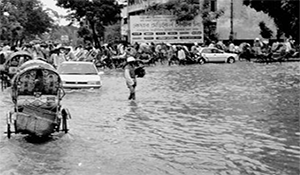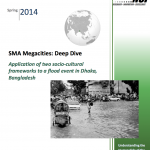Megacities: Socio-cultural Analysis Dhaka, Bangladesh

SMA Megacities: Deep Dive Application of two socio-cultural frameworks to a flood event in Dhaka, Bangladesh.
Author | Editor: Bragg, B,, Brickman, D., Canna, S. & Desjardins, A. (NSI, Inc).
The Strategic-Multilayer Assessment (SMA) Megacity Reconnaissance, Surveillance, and Intelligence (M- RSI) project seeks to aid United States Pacific Command (USPACOM) in understanding socio-cultural dynamics within megacities. For this portion of the project, USPACOM socio-cultural analysis (SCA) planning frameworks (“the SCA approach”) were used to guide remote data collection for a proto-type assessment of the risk of humanitarian crisis in Dhaka, Bangladesh. The SCA approach consists of five distinct, yet related frameworks1 that are designed to provide planners with a quick triage tool to assess risk, as well as provide a guide for analysts conducting longer-term assessments. The five frameworks are structured to reflect USPACOM’s mission objectives and planning process. Given this was a proof of concept effort, analysts were asked to apply two of the five SCA frameworks—the SCA Humanitarian Crisis (HC) Framework and the Intra-state Violence (IV) Framework—to Dhaka, Bangladesh.
In addition to identifying the key risk factors for humanitarian crisis in Dhaka, this study considered the following question regarding the connection between a humanitarian crisis and the risk of intrastate violence/VEO activity in Dhaka:
- Could government/NGO failures to provide immediate relief and rescue in the event of a humanitarian crisis in Dhaka enhance support for VEO-affiliated groups in the city?
The effort represents an initial attempt to expand the use of the SCA frameworks by linking risks in one framework to risks in another as well as determining relationships between, and joint impacts of, framework elements.
During non-crisis (Phase 0) periods, the SCA Humanitarian Crisis framework described below can be used to help analysts and planners track the general nature of the risk of humanitarian crisis. As shown in Figure 1, humanitarian crises can be triggered by one of a number of factors—some environmental (floods) and some socio-political (conflict). All create a unique set of risks for those affected and those seeking to respond. The level and type of risk of humanitarian crisis is determined by the level of services (law enforcement, health and medical, and utilities) the government provides, the readiness and response capabilities, and the recovery capacity of the affected area.
Utilizing data and information remotely collected—to include quantitative and qualitative data, academic research, news reports, and international and NGO policy documents and reports—analysts were able to conduct a quick triage risk assessment of the area of interest, in this case of Dhaka, Bangladesh. For example, they were able to determine how the quality of roads in Dhaka (route trafficability) affected the risk of humanitarian crisis in the event of a natural hazard such as a flood. Analysts employed a simple five-point qualitative coding scheme ranging from no appreciable risk to severe risk to quickly measure risk factors. Roll-up to higher levels was accomplished by applying a simple ordinal measure to these assessments. The “no appreciable risk” elements were scored as 1 (color coded green); low risk of failure as 2 (color coded yellow); moderate risk as 3 (color coded orange); severe risk as 4 (color coded red); and elements that had insufficient information to evaluate were scored as 0 (color coded grey).
Analysts began with a triage assessment of the overall humanitarian crisis factors before delving into analysis of risk in the context of severe flooding. The HC Framework contains factors relating to three stages of disaster relief: immediate impact, disaster response and responsibilities, and recovery and reconstruction. It was important to separate these phases/functions as the information on even the same elements (e.g., actors, procedures, and risk conditions) differs for each. Conducting a deep dive on a single factor allowed analysts to tailor the information related to each element in the risk framework to a specific condition and thus produce more tactical and operational analyses. For example, how flooding may impact the risk of humanitarian crisis due to the flood effects on potable water or delivery of medical supplies to areas in need. Upon completing analysis of the risk of flood-driven humanitarian crisis in Dhaka, analysts conducted a preliminary assessment of how such conditions may increase the risk of intrastate violence emerging as the result of such a flood.
Chapter Two provides an overview of Dhaka as well as a quick holistic assessment guided by the SCA HC Framework of individual factors relevant to assessing the risks of humanitarian crisis. Chapters Three through Five contain detailed assessment of a subset of framework risk factors of importance in the context of a flood in terms of immediate impact, institutional plans and responsibilities, and recovery. Chapter Six discusses how these risk factors relate to, and impact, the IV Framework as applied to Dhaka. Chapter Seven discusses implications for USPACOM and Chapter Eight provides a short discussion on the importance and unique challenges associated with megacities.

Comments